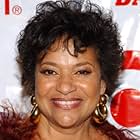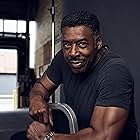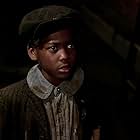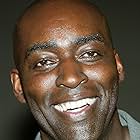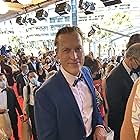It starts as a little kid and shows the man behind the legend grow up to the nbaIt starts as a little kid and shows the man behind the legend grow up to the nbaIt starts as a little kid and shows the man behind the legend grow up to the nba
Photos
Chris Jacobs
- Buzz Peterson
- (as Christopher Jacobs)
Desi Arnez Hines II
- Leroy Age 15
- (as Desi Arnes Hines II)
Dari Gerard Smith
- Michael Age 6
- (as Dari G. Smith)
- Director
- Writers
- All cast & crew
- Production, box office & more at IMDbPro
Storyline
Did you know
- TriviaNicole French's debut.
- GoofsWhile playing at North Carolina, Michael Jordan is wearing late 90's era Nike tennis shoes. In college and on the 1984 Olympic team, Jordan and his teammates wore The Converse Weapon.
- SoundtracksI'm Glad You're Mine
Written by Rodney Saulsberry, Peter Jay Brown and Janet Cole Valdez
Performed by Rodney Saulsberry
Featured review
Rating: 2 out of 10; 1/2 Star
Part I
This television movie ("Michael Jordan: An American Hero") is a perfect example of an idea that should have gone no further than lunch conversation.
First, I'll address the general task of making average to below-average basketball players look like great players on film. Usually, this fails miserably. Filmmakers like to employ cutaways, basketball doubles, trampolines, 8 foot rims, and the like, to try to make actors look like basketball legends, and it just doesn't come off. This is especially true of film depictions of NBA basketball. The game has a fluid look on television. There are no cutaways for dunks and shots. We see most of the action in continuous shots. Filmmakers, on the other hand, like to show an actor leap into the air or shoot the ball, then cutaway to a low shot of that actor in mid-air or a shot of the ball in the air, then cutaway to the actor throwing the ball through the basket or a shot of the ball going through the basket. All this editing magic does is bring home the reality that we are watching some actor, who is probably an average athlete at best, try to convince us that he is one of the greatest athletes of all-time (in this case, Michael Jordan). It doesn't work. However, that is not to say that films cannot convincingly portray great athletes on screen. It's just easier with most other sports. Football and hockey players play in uniforms that obscure facial details, so real players can double for actors in game scenes. Baseball is televised in the visual cutaway style often employed in film, so filmmakers can use cutaways to make up for athletic shortcomings of actors. Basketball is different. At its highest level, it is a game played by big men in three dimensions, and players do not wear masks or helmets. Audiences can tell when a 6-foot-three actor playing 6-foot-six is dunking on a 9-foot-rim doubling as a 10-foot-rim. It's a matter of scale. So the task of having actor, Michael Jace (6-foot-three)convincingly re-enact playing career moments of Michael Jordan (6-foot-six) had built in problems. As it happens, Michael Jace bears a reasonable physical resemblance to Michael Jordan, when Jace is playing the bald, late 20s, early 30s, Michael Jordan. However, Jace makes a poor late teens, early 20s, Michael Jordan, and the makeup department gives Jace an awful wig (about an inch too long) to play the younger Jordan.
As for the rest of the cast, the familiar faces are all fine actors in their own right (Ernie Hudson as James Jordan, Debbie Allen as Delores Jordan, and Robin Givens as Juanita Jordan). However, they are all completely wrong for their roles, as each bears almost no resemblance to their real-life counterparts. Albert Hall ("Apocalypse Now") would have made a much better James Jordan, JoMarie Payton ("Family Matters") would have made a much better Delores Jordan, and Cynda Williams ("One False Move", "Mo' Better Blues") would have made a much better Juanita Jordan. However, the filmmakers were more concerned with getting higher profile actors to portray Michael Jordan's close family members than with getting good actors who bore some physical resemblance to these family members. The filmmakers probably could have saved money with actors who were better choices for these roles.
As for this film's version of Michael Jordan's life, it's awful. At times, it's unclear as to what event is being depicted, at other times, it inappropriately changes key moments of events for dramatic purposes, and at other times, it's just bad. I shall address some of these problems in the order that they occurred in the film: (1) Jordan's March 1995 comeback game - in real life, it was vs. the Indiana Pacers, at Market Square Arena in Indiana; in the film, it appears to be vs. the New York Knicks in Chicago. (2) Michael Jace takes over the Jordan role as Jordan prepares to head to North Carolina for his freshman year of college; Jace looks at least 10 years older, at this point in the story, than the actor who portrayed Jordan in Jordan's last two years of high school. (3) Dean Smith - some chubby guy with brown hair appears to portray North Carolina's men's basketball team head coach; he looks nothing like Dean Smith; the film doesn't even mention the name "Dean Smith", probably because the filmmakers didn't bother to cast an actor who looked anything like Dean Smith; this seems a major oversight for the role of such an important figure in Jordan's basketball development. (4) Player resemblance - there is not a player depicted in this film who is portrayed by an actor who looks more than remotely like that player, except for Jace as Michael Jordan. (5) No official NBA team logos, court logos, stadium logos - kills reality.
(more later)
Part I
This television movie ("Michael Jordan: An American Hero") is a perfect example of an idea that should have gone no further than lunch conversation.
First, I'll address the general task of making average to below-average basketball players look like great players on film. Usually, this fails miserably. Filmmakers like to employ cutaways, basketball doubles, trampolines, 8 foot rims, and the like, to try to make actors look like basketball legends, and it just doesn't come off. This is especially true of film depictions of NBA basketball. The game has a fluid look on television. There are no cutaways for dunks and shots. We see most of the action in continuous shots. Filmmakers, on the other hand, like to show an actor leap into the air or shoot the ball, then cutaway to a low shot of that actor in mid-air or a shot of the ball in the air, then cutaway to the actor throwing the ball through the basket or a shot of the ball going through the basket. All this editing magic does is bring home the reality that we are watching some actor, who is probably an average athlete at best, try to convince us that he is one of the greatest athletes of all-time (in this case, Michael Jordan). It doesn't work. However, that is not to say that films cannot convincingly portray great athletes on screen. It's just easier with most other sports. Football and hockey players play in uniforms that obscure facial details, so real players can double for actors in game scenes. Baseball is televised in the visual cutaway style often employed in film, so filmmakers can use cutaways to make up for athletic shortcomings of actors. Basketball is different. At its highest level, it is a game played by big men in three dimensions, and players do not wear masks or helmets. Audiences can tell when a 6-foot-three actor playing 6-foot-six is dunking on a 9-foot-rim doubling as a 10-foot-rim. It's a matter of scale. So the task of having actor, Michael Jace (6-foot-three)convincingly re-enact playing career moments of Michael Jordan (6-foot-six) had built in problems. As it happens, Michael Jace bears a reasonable physical resemblance to Michael Jordan, when Jace is playing the bald, late 20s, early 30s, Michael Jordan. However, Jace makes a poor late teens, early 20s, Michael Jordan, and the makeup department gives Jace an awful wig (about an inch too long) to play the younger Jordan.
As for the rest of the cast, the familiar faces are all fine actors in their own right (Ernie Hudson as James Jordan, Debbie Allen as Delores Jordan, and Robin Givens as Juanita Jordan). However, they are all completely wrong for their roles, as each bears almost no resemblance to their real-life counterparts. Albert Hall ("Apocalypse Now") would have made a much better James Jordan, JoMarie Payton ("Family Matters") would have made a much better Delores Jordan, and Cynda Williams ("One False Move", "Mo' Better Blues") would have made a much better Juanita Jordan. However, the filmmakers were more concerned with getting higher profile actors to portray Michael Jordan's close family members than with getting good actors who bore some physical resemblance to these family members. The filmmakers probably could have saved money with actors who were better choices for these roles.
As for this film's version of Michael Jordan's life, it's awful. At times, it's unclear as to what event is being depicted, at other times, it inappropriately changes key moments of events for dramatic purposes, and at other times, it's just bad. I shall address some of these problems in the order that they occurred in the film: (1) Jordan's March 1995 comeback game - in real life, it was vs. the Indiana Pacers, at Market Square Arena in Indiana; in the film, it appears to be vs. the New York Knicks in Chicago. (2) Michael Jace takes over the Jordan role as Jordan prepares to head to North Carolina for his freshman year of college; Jace looks at least 10 years older, at this point in the story, than the actor who portrayed Jordan in Jordan's last two years of high school. (3) Dean Smith - some chubby guy with brown hair appears to portray North Carolina's men's basketball team head coach; he looks nothing like Dean Smith; the film doesn't even mention the name "Dean Smith", probably because the filmmakers didn't bother to cast an actor who looked anything like Dean Smith; this seems a major oversight for the role of such an important figure in Jordan's basketball development. (4) Player resemblance - there is not a player depicted in this film who is portrayed by an actor who looks more than remotely like that player, except for Jace as Michael Jordan. (5) No official NBA team logos, court logos, stadium logos - kills reality.
(more later)
Details
- Release date
- Country of origin
- Language
- Also known as
- American Hero: The Michael Jordan Story
- Production company
- See more company credits at IMDbPro
Contribute to this page
Suggest an edit or add missing content

Top Gap
By what name was Michael Jordan: An American Hero (1999) officially released in Canada in English?
Answer


